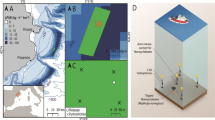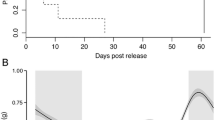Abstract
Acoustic telemetry was used to examine patterns of activity and space utilisation of coelacanths, nocturnal predators which spend the day in submarine caves. Nine coelacanths (Latimeria chalumnae) were tracked, each for a period of 1 to 16 nights at Grande Comore, West Indian Ocean. Activities lasted on average 9 h, usually starting shortly after sunset and ending before sunrise. Vertically, coelacanths moved up and down at and below cave level by following the bottom contour, mainly between 180 and 400 m depth. The deepest record was 698 m, the shallowest 133 m. Most time was spent between 200 and 300 m depth. Large individuals performed deep excursions to depths below 400 m, usually once per night. The fish spent most time in water temperatures of 15 to 19 °C; they rarely ventured into waters warmer than 22 °C measured at depths shallower than 160 m depth. Horizontally, coelacanths stayed in narrow areas ranging from <1 to 10 km of coastline. Coelacanths are extremely slow drift-hunters with an estimated average swimming speed of 3.2 m min−1, often travelling not more than 3 km per night. They probably take advantage of local upwelling and downwelling and slow currents occurring parallel to the steep slopes. This study shows that coelacanths are inhabitants of the subphotic zone, where they are active mainly below the depth of their daytime refuges.
Similar content being viewed by others
Author information
Authors and Affiliations
Additional information
Received: 7 July 1999 / Accepted: 11 February 2000
Rights and permissions
About this article
Cite this article
Hissmann, K., Fricke, H. & Schauer, J. Patterns of time and space utilisation in coelacanths (Latimeria chalumnae), determined by ultrasonic telemetry. Marine Biology 136, 943–952 (2000). https://doi.org/10.1007/s002270000294
Issue Date:
DOI: https://doi.org/10.1007/s002270000294




